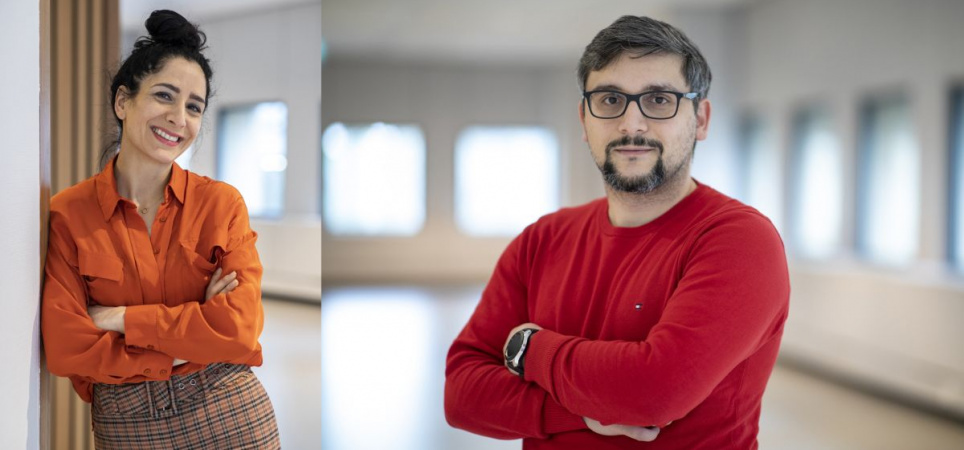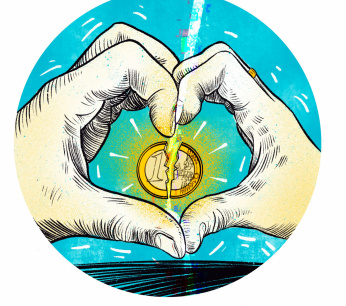Bicultural student is looking for a role model
There is a gap between the multicultural student population and the predominantly white teaching staff of the Hogeschool van Amsterdam. That is why the university of applied sciences trains XNUMX recent graduates with a bicultural background to become lecturers.

Picture: Fred van Diem
Biologist Ely Çilingir, a native of Arnhem with Turkish roots, has been a trainee teacher at the architecture department of the Amsterdam University of Applied Sciences (AUAS) since November. He has a master's degree in water management and has been recruited to teach in that field. But it is just as important that he will function as a role model and point of contact for bicultural students so that they feel more at home at the university of applied sciences. “That really appealed to me,” says Çilingir. Although he was a little concerned about whether those students would be able to find him. “The beta in me was skeptical. But during the first week, to my surprise, a student with a migration background came to me. How nice to meet a teacher from a different culture here, she said to me. But she thought I was of Italian descent ”, he adds with a laugh. "And I had also completely misjudged her ethnic background."
I know what you run into when you live in two cultures
Çilingir is one of forty trainees that AUAS is recruiting to better align its workforce with the multicultural student population. They are being prepared to coach students for the first hundred days of their studies, because many first-years drop out during that period. “If you want to increase study success, good contact is essential and that goes better if a student can identify with a teacher,” says Çilingir. "You also see that with students, they are much easier to ask for a female teacher."
The dropout rate at AUAS is alarmingly high. 17 percent of the entrants stop their studies within a year and 22 percent switch to another study program. Students with a migration background and first generation students are overrepresented among dropouts. Ultimately, less than 45 percent of a class graduates within five years. This means that the study success at AUAS is 5 percentage points below the already meager national average of 50 percent.
Every student must be able to feel at home at the university regardless of his social origin or cultural background, is the starting point of the AUAS's diversity policy. Therefore the workforce must reflect the student population. That is certainly not the case now. A poll conducted by Statistics Netherlands shows that only 11 percent of AUAS employees have a non-Western migration background, while this is the case for 27,6 percent of students. Increasing the percentage of bicultural employees is therefore an important spearhead. It should be 2022 percent by the end of 20.
Pioneers
“That is not easy,” says Aliye Altintas-Çelik, project manager diversity and inclusion. "When you see how long we have been working on this in higher professional education, it is clear that an intervention is really needed." Çelik was recruited a year ago to shape the college-wide trainee program. “It is intended as a concrete start, as an impulse with which we show that teachers with a bicultural background can make a difference. We have now hired 27 trainees, this year we want to grow to forty. ”
Most trainees are newly graduated AUAS students. “They are experts by experience. They know what it's like to walk around here as a student ”, says Çelik. The trainees go through a three or four-year apprenticeship trajectory in which they follow the basic course didactics for HBO teachers and can obtain a master's degree if they do not already have one. They are coached and their training pays special attention to diversity and inclusion. “There are monthly peer meetings where they can contribute their case studies in a safe setting,” says the project manager. “Once every six weeks, we organize an inspirational meeting in which themes such as 'women at the top' or 'ethical leadership' are discussed. And they choose their own development issue in the field of diversity. For example, they can examine teaching materials or conduct research into why certain groups of students drop out more often. ”
I had to find out everything myself. I could have used more help with that
“The trainee program is much more than a teacher training,” says Ely Çilingir. “It is pioneering, developing something new to help students with a migration background. I came to that. I am someone who likes to help others. I have always helped my nephews and nieces with their homework and, in addition to my studies, I taught children with a migration background. ”
As a trainee he can use his own experience as a first generation student. "I can put myself in the shoes of those students because I know what you encounter when you live in two cultures." But it is not only about cultural differences, social origin also plays a role, Çilingir knows. “I am a descendant of guest workers and therefore come from a working class environment. I have very helpful parents who consider studying very important, but they themselves have no higher education. From secondary school I had to find out everything myself. I could have used more help from empathic teachers who understand what students like me are struggling with. ”
Double chance
Although trainees are in principle trained to be teachers, there is also room for development in other areas. Stephanie Glasgow is a teacher of pedagogy and has been a teacher at the Roc in Amsterdam for six years. She saw a vacancy on Linkedin last summer in which a trainee educational development for the faculty of technology was being sought. “I have wanted to gain experience with educational development for some time because I think it will deepen your teaching position. As a trainee, you can also do a master's degree, which is necessary to become a higher vocational education teacher. A double chance. ” Glasgow only discovered during the application procedure that the trainee process is also about increasing the diversity of the AUAS workforce.
In her position she is not a point of contact for students. “I think it's great that my presence allows me to be a role model for students with a similar background,” says the Alkmaar-born trainee with Surinamese parents. “It is of course good if students from different origins can identify with the employees. But that's not all about ethnicity or religion. As a mother of two young children with a full-time job, I also set an example. ”
It is often said that there are no teachers with a migration background, but that is not true
Not every expert is suitable as a trainee. “We are looking for people with a sensitivity to cultural differences who are passionate about education. But of course they must also want to be role models ”, says Aliye Çelik. During their training, the trainees are in scale 9, if they have completed their didactic course and master, a permanent appointment in scale 10 awaits.
Despite the high demands, it is not difficult to find suitable candidates. “We receive a huge number of responses to the vacancies, even for courses where vacancies are not always filled immediately,” says Çelik. “For example, it was no problem at all to find seven trainees for the technology faculty. There are even three prospective math teachers among them. It is often said that there are no teachers with a migration background, but that is not true. It is also an attractive position ”, the project manager continues. "And we offer starting teachers optimal guidance and maximum personal growth."
Misunderstanding
That is also allowed, because the trainees also have a difficult task. They oppose the social climate. The hotline about left-wing indoctrination in education that the Forum for Democracy has set up has resonated with AUAS students. President of the Executive Board Huib de Jong was forced to explain in his New Year's speech that the AUAS is not left wing because employees are concerned with themes such as inequality, sustainability and diversity. "The AUAS is not a political or religious organization, but a knowledge organization."
Initially there was also resistance in the workplace to attracting trainees with a bicultural background. “It's sensitive because it looks like positive discrimination, but that's a misunderstanding,” says Çelik. “We do not favor candidates with a bicultural background in applications. We are hiring these trainees precisely because they have extra baggage. ”
“It is not the case that with this program we give trainees a chance to become a teacher, we as a university of applied sciences get a chance to learn from them,” emphasizes Çelik. "And we have to invest a hell of a lot in them to make sure they want to stay with AUAS."
This article appeared in the Education Magazine in April 2020. The Education Magazine in your mailbox every month? Become a member!
Want to read more about diversity in higher professional education? For the March issue, the Education magazine interviewed Asis Aysan, a Dutch teacher who sees a gap between his originally Dutch and his bi-cultural students: 'It's not enough to put up with each other'


